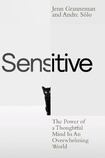
I didn’t need this book to discover that I am sensitive. My dad could have told you that when, aged three, I needed my fruit mashed and my meat lumpy. My primary schoolteacher could have made that assumption at my requirement to sit at least two rows away from her coffee cup, or my ex, when I cried after he had an unsatisfactory trip to the cinema. In fact, should I choose to employ modern therapy speak, I may even begin to consider myself a HSP (Highly Sensitive Person) but unfortunately, as a sensitive person, this term makes me gag.
This book did, however, affirm many challenges that, as a sensitive person, I have felt and struggled to make understood. Absorbing other people’s moods, requiring additional down time, aversion to numerous smells and textures – you are not weird, my pal, you are sensitive.
Importantly, this book explores both the physical and emotional components of sensitivity – the physical characterised by sensory stimulation and overload, that often goes unrecognised and mischaracterised as “fussy”. The emotional component imputed as being “dramatic” or “overly-emotional”.
“Sensitivity is defined as the ability to perceive, process, and respond deeply to one’s environment.” Such definitions provide useful tools for the reader, as does advice for navigating sensory overload and raising the next generation of sensitive children. However, I find the repeated affirmations that your sensitivity is a superpower a little grating, if not reductive. As humans, we are not defined by a singular gene or trait but are rather a smorgasbord of wonderful contradictions. Additionally, with 30 per cent of the population considered to fall under the sensitive category, it would be imprudent to consider all the same.
READ MORE
Certain aspects of the book feel a little “Tik Tok therapy” or what would formerly be considered “teen magazine”. Concepts are generalised and simplified, and pseudo-diagnoses delivered. Frustrating, also, is the authors’ correlation of sensitivity, empathy and compassion. While these traits share many overlapping features, they are not interchangeable terms.
On the flipside, the book serves to debunk the “Toughness Myth” and destigmatise many aspects of sensitivity. If you are a sensitive person, if nothing else, this book will provide reassurance that you are not alone in your experience of this “loud, fast, too-much world”.
[ The intriguing link between sensitivity to physical and psychological painOpens in new window ]















